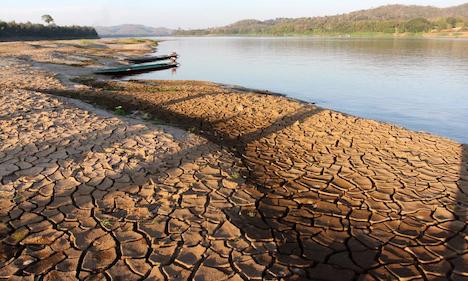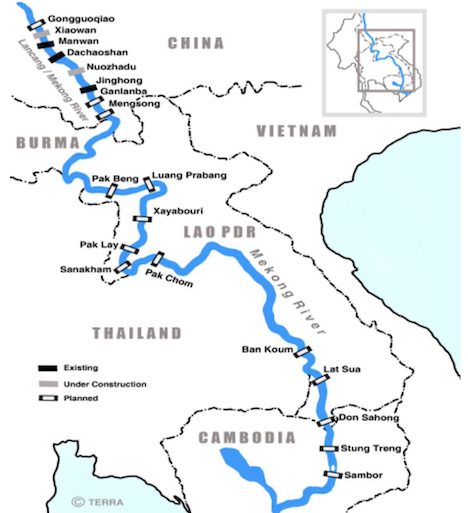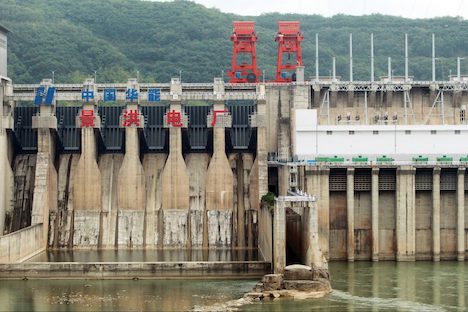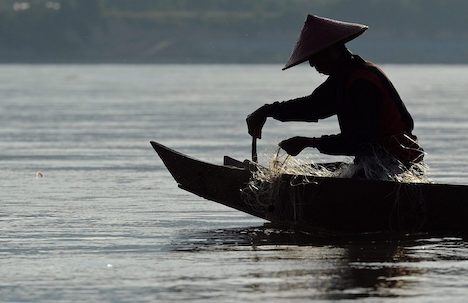Massive new hydropower dams are parching the once mighty river’s water levels to lowest in 60 years
A confluence of drought and dams along the Mekong River has renewed concerns about the future of the 4,700-kilometer waterway, upon which tens of millions of people depend for their livelihoods in China, Laos, Myanmar, Thailand and Vietnam. The number of dams impeding the Mekong’s flow is fast multiplying, drying up segments of the once fast-flowing river and leaving the region facing imminent drought, according to the Mekong River Commission, a regional intergovernmental body that aims to jointly manage the river’s water resources. Laos’ Don Sahong, the newest of dozens of Mekong dam projects, began generating electricity close to the Laos-Cambodia border in November. Most of its generated power will be exported to Thailand and Cambodia. A month earlier, the much bigger 1.3-gigawatt Xayaburi dam and hydropower project started to produce electricity in northwestern Laos, the self-proclaimed power-producing “battery of Asia” through which 35% of the Mekong flows Its electricity will be exported chiefly to Thailand. “China’s operators of the Jinghong Dam and the Thai operators of the newly opened Xayaburi dam in Laos conducted operations that actually exacerbated the drought,” said Brian Eyler, director of the Southeast Asia program at the Stimson Center, a US think tank. “Those dams and more than 70 others now operational in Laos and China all contribute to deteriorating downstream conditions related to the drought.” As economies such as Cambodia and Vietnam continue to expand even amid a global slowdown at 6-7% a year and aim to catch up with wealthier neighbors such as Thailand, regional demand for electricity is still fast growing.
Countries across Asia are building dozens of new coal-fired power plants to meet the rising demand while at the same time sparking concerns about the impact on climate change of greater coal use. But hydropower dams, although a cleaner alternative to coal, are also threatening environmental disaster. And regional governments, keen to maintain economic growth and spur development, appear determined to push ahead regardless of the adverse impacts. “Regional policymakers, energy ministers, they are totally consumed by infrastructure development,” said Pou Sothirak, director of the Cambodian Institute for Cooperation and Peace and an ex-energy minister, at a recent Mekong River discussion held at Chulalongkorn University in Bangkok. “They just want more energy – they are consumed by the idea that dam-building will improve their national economy.” “The impacts of dams both on the mainstream and tributaries have been widely predicted for more than a decade and now they are beginning to play out in the basin with a game-changing gravity,” warns the Stimson Center’s Eyler, who is also author of the book Last Days of the Mighty Mekong. According to the International Rivers, a non-governmental organization, the Xayaburi dam is a “highly controversial project due to widespread concerns over its expected impacts on the river system.” The NGO describes the 260-megawatt Don Sahong dam, meanwhile, as threatening “vital Mekong River fisheries and the area’s biological wealth.” As both the Xayaburi and Don Sahong dams commenced operations in the past month, the MRC has warned of “severe to extreme drought” that it expects “to hit countries in the lower Mekong basin from now until January 2020.” While the MRC stated that the drought is caused by “insufficient rainfall during the wet season” and an “El Nino event” that has created “abnormally high temperature and high evapotranspiration,” others are pointing at China’s ever-growing number of dams on the upper reaches of the Mekong as the main culprit.
“The Chinese dams present a certain challenge,” said Thitinan Pongsudhirak of Bangkok’s Chulalongkorn University. “When the water is low, sometimes we have a drought and it appears the Chinese dams have more control leverage over how the water flows and how much it flows downstream,” Thitinan said at the same Mekong seminar held at his university. Sothirak told the same forum that “the Mekong river is under sever stress, imposed mainly, though not exclusively, by dam-building.” He added that China’s dams are “far larger than any dam built downstream.” In mid-November, the MRC put the Mekong River’s water levels at their lowest in 60 years; other estimates suggest that water levels have dropped to their lowest level in a century. The strongest impact of a degraded Mekong is likely to be felt around the river’s delta in southern Vietnam, the country’s rice bowl and where sits Ho Chi Minh City, the country’s commercial capital and biggest urban area. Lower freshwater river levels mean that saltwater levels in the delta could rise, threatening rice-growing and agriculture, while agriculture irrigated by the river could suffer if nutrient-rich sediment is blocked from flowing downriver by dams. That appears to already be happening, given that stretches of the river in Laos are an oceanic blue rather than its usual and renowned muddy-brown. Despite such concerns, Vietnam has seemingly dialled back its long-standing opposition to dams on the Mekong by backing and funding a proposed 1,410-megawatt (MW) hydroelectric dam near the world heritage riparian town of Luang Prabang in Laos. It’s all a far cry from 2011, when the Vietnamese government called for a halt to Xayaburi due to concerns of its downstream effects. The growing adverse impact on the Mekong Delta in Vietnam has even prompted civil society groups to jettison their caution of criticizing the government over its changing dam stance, a daring shift given the ruling communists’ penchant for jailing critics.
Yet there have already been news reports from Vietnam of so-called “climate change refugees” fleeing deteriorating environmental conditions, including persistent drought, in the Mekong Delta and migrating into urban centers. Cambodia, too, could suffer if the degraded Mekong and drought leads to a serious disruption of the annual flow reversal into the Tonle Sap, Southeast Asia’s biggest lake, which is connected by a smaller tributary to the Mekong. The phenomenon leads to huge fish catches on the lake, and later sends fish, nutrients and sediment up and down the river. “This year’s reversal and heartbeat effect was severely stunted and will deliver severe food shortage effects related to the lack of fish,” said Eyler, while Sothirak warned that maintaining the Mekong is vital for “sustaining life of those countries along the river.” Source URL |



